How Can You Use Ergonomic Chairs for Better Focus?
Like a finely-tuned instrument that produces the perfect note, your office chair can orchestrate your daily focus and productivity. You’ll find that proper ergonomic support affects more than just your physical comfort – it’s a direct link to your mental performance and sustained concentration. When you’re settling into your workstation, your chair’s design can either enhance or diminish your cognitive abilities. Let’s explore how to choose ergonomic chairs for better focus to transform your work experience.
Key Takeaways
- Proper spinal alignment from ergonomic chairs enhances blood flow to the brain, directly improving cognitive performance and mental clarity.
- Research shows ergonomic chairs increase productivity by 17% while reducing discomfort breaks.
- Customizable features like lumbar support and seat depth prevent distracting pain and muscle fatigue during focused work.
- Dynamic support systems encourage micro-movements, keeping the body engaged and mind alert throughout workday tasks.
- Synchronized tilt mechanisms maintain ideal body angles, reducing mental energy spent on compensating for poor posture.
The Science Behind Ergonomic Chair Design
Ergonomic chair design integrates biomechanical principles with human anatomy to create seating that supports natural posture and movement.
When you’re selecting an ergonomic chair, you’ll find that key design elements stem from extensive research into spinal alignment, muscle activation patterns, and pressure distribution across contact points.
Advanced ergonomic principles incorporate adjustable features that adapt to your unique body dimensions and work habits.
The science focuses on dynamic support systems that encourage micro-movements while maintaining core stability.
Modern chair materials, from breathable mesh to high-density foam composites, are engineered to provide ideal temperature regulation and weight distribution.
These materials work in conjunction with carefully calculated angles and pivot points to reduce muscle strain and promote blood circulation, ultimately supporting your body’s natural mechanics throughout the workday.
Impact of Proper Posture on Mental Clarity
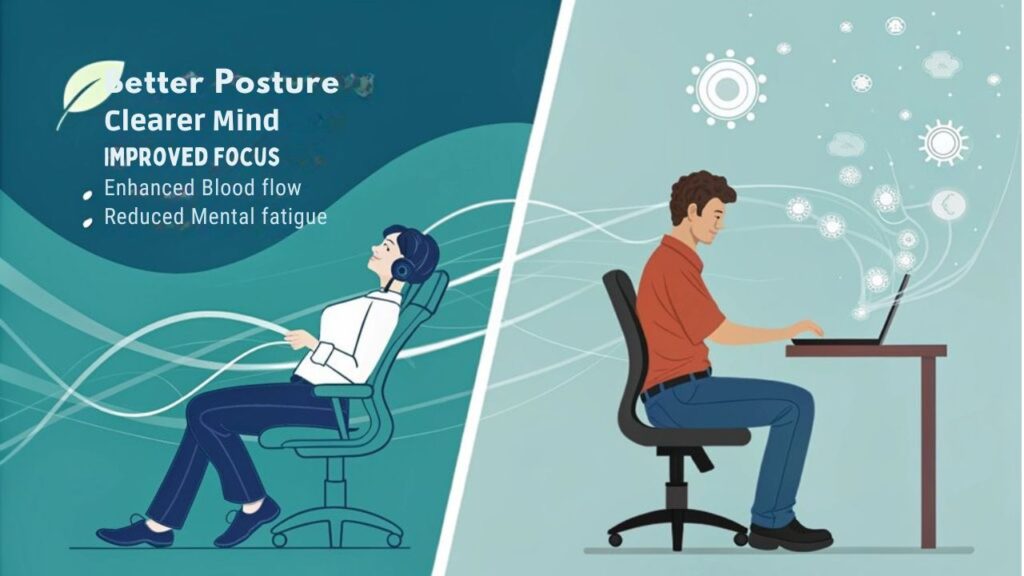
When you maintain proper alignment in an ergonomic chair, your brain receives ideal blood flow and oxygen, leading to enhanced cognitive performance throughout your workday.
You’ll experience less mental fatigue as your body works efficiently without wasting energy on compensating for poor posture. Your improved physical positioning directly supports stress-free focus, allowing you to concentrate more effectively on complex tasks.
Alignment Boosts Brain Function
Research indicates that proper spinal alignment directly influences cognitive performance and mental acuity. When you maintain ideal posture through ergonomic seating, you’re supporting vital neural pathways that affect your brain’s processing capacity.
This cognitive alignment creates an environment where your brain can function more efficiently, reducing the mental strain of compensating for poor posture.
You’ll notice enhanced focus and clearer thinking when your spine is properly aligned, as your nervous system can transmit signals without interference.
This enhancement of brain health stems from improved blood flow and reduced muscle tension in your neck and shoulders.
Reduced Mental Fatigue Daily
Poor posture drains mental energy by forcing your body to compensate for misalignment throughout the day.
When you’re constantly shifting to find comfort, your cognitive load increases, reducing your ability to focus on important tasks. An ergonomic chair helps maintain proper posture, preserving your mental stamina for productive work rather than physical discomfort.
Here’s how an ergonomic chair reduces daily mental fatigue:
- Supports natural spine curves, eliminating the need for your brain to process position adjustments
- Minimizes muscle tension that diverts mental resources from critical thinking
- Stabilizes your seated position, allowing you to direct more cognitive energy toward complex problem-solving
Stress-Free Concentration Improvement
Maintaining proper posture through ergonomic seating directly enhances your mental clarity and ability to concentrate. By supporting your spine’s natural alignment, an ergonomic chair reduces physical tension that can interfere with cognitive functions.
You’ll experience improved blood flow to your brain, leading to heightened focus and mental processing. The cognitive benefits extend beyond basic comfort.
When you’re not constantly shifting to find a comfortable position, your mind remains engaged with tasks rather than distracted by discomfort. This automatic stress management through proper ergonomic support allows your brain to allocate more resources to complex thinking and problem-solving.
You’ll notice sharper decision-making abilities and sustained concentration throughout your workday, as your body and mind work in harmony rather than opposition.
Key Features of Focus-Enhancing Office Chairs
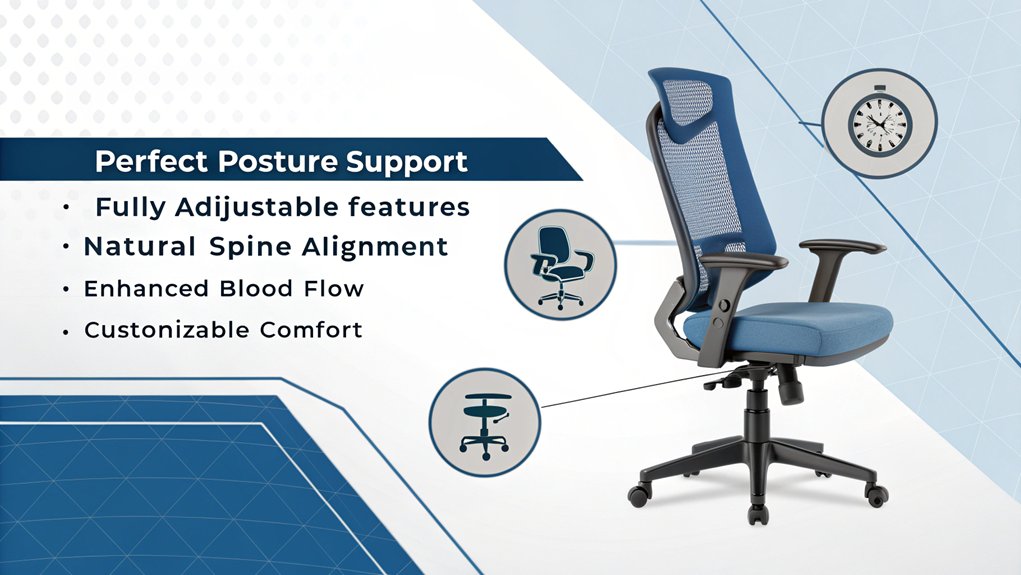
When selecting an ergonomic office chair, you’ll want to prioritize features that offer customizable support for your spine, arms, and legs through independently adjustable components.
Your chair’s height, armrests, seat depth, and lumbar support should adapt to your unique body proportions and workspace setup.
The chair’s design should naturally guide you into proper alignment by incorporating a supportive backrest tilt, adequate seat cushioning, and a waterfall front edge that reduces pressure on your legs.
Adjustable Support Components
To maximize focus during long work sessions, ergonomic chairs must include several adjustable support components. The key is finding a chair that adapts to your unique body mechanics and work style.
An adjustable lumbar support lets you align the chair’s contours with your spine’s natural curve, while proper seat height positioning guarantees your feet rest flat on the floor.
- Multi-axis armrests that move up/down, forward/back, and pivot inward/outward to support various tasks
- Synchronized tilt mechanism that maintains ideal angles between your torso and thighs as you recline
- Adjustable seat pan depth to accommodate different leg lengths and reduce pressure behind the knees
These customizable elements work together to create a dynamic seating experience that enhances your ability to stay focused and productive.
Posture Promoting Design
A well-designed ergonomic chair promotes proper posture through strategic features that align your spine and engage core muscles.
You’ll find innovative posture correction elements like synchronized tilt mechanisms that maintain ideal hip-to-spine angles as you move, and dynamic seat pans that encourage micro-movements to keep your core engaged.
The chair’s ergonomic benefits extend beyond basic lumbar support through integrated design features that work together.
You’ll experience enhanced postural awareness from contoured backrests that guide your spine’s natural curves, while waterfall-edge seats reduce pressure on your thighs.
The chair’s balanced weight distribution system automatically adjusts to your movements, preventing slouching and helping you maintain an alert, focused position throughout your workday.
Health Benefits Beyond Productivity
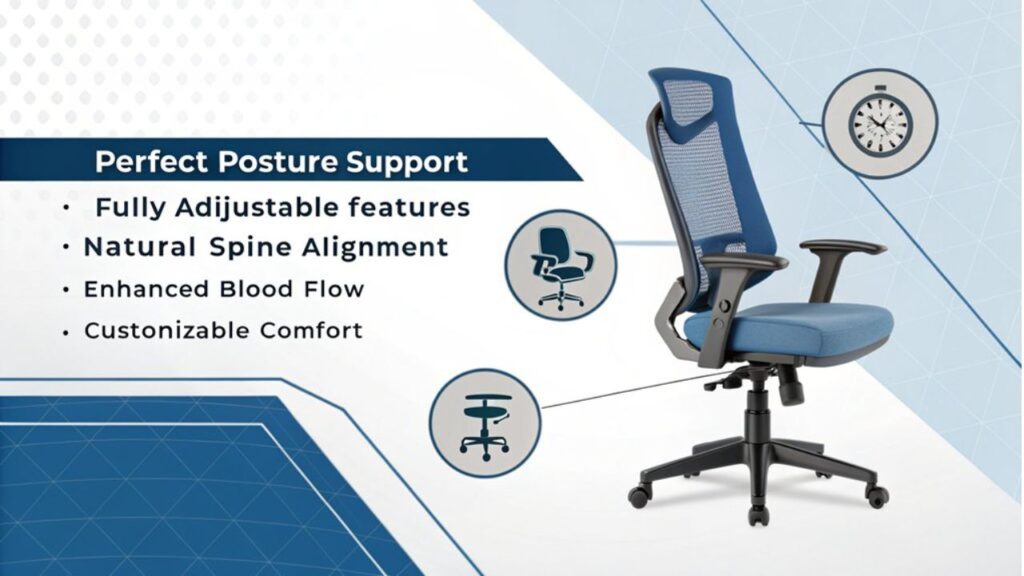
Beyond enhancing workplace productivity, ergonomic chairs deliver essential health benefits that impact your overall well-being. When you choose ergonomic chair styles with proper lumbar support and advanced chair material benefits, you’ll experience significant improvements to your health.
Modern ergonomic designs actively combat common office-related health issues through innovative engineering and adaptive materials.
Consider these key health advantages:
- Reduces pressure on your spine by up to 40% through dynamic weight distribution and adjustable support mechanisms.
- Minimizes muscle strain and fatigue by promoting natural body alignment with temperature-regulating mesh materials.
- Prevents circulatory issues through waterfall seat edges and responsive cushioning that maintains proper blood flow.
These benefits extend far beyond your workday, contributing to long-term musculoskeletal health and reducing the risk of chronic conditions.
Customization Options for Personal Comfort

While every person’s body composition and comfort needs differ, modern ergonomic chairs offer extensive customization features that let you fine-tune your seating experience.
You’ll find adjustable features that accommodate your personal preferences, from seat height and depth to armrest positioning and lumbar support intensity. Most premium models allow you to modify the tilt tension and angle of recline, helping you maintain ideal posture throughout your workday.
To match your unique body mechanics, you can also customize the headrest height and angle, ensuring proper neck alignment during both focused work and brief moments of rest.
The chair’s synchro-tilt mechanism lets you set the precise resistance level when leaning back, while the seat pan’s adjustable depth helps prevent pressure points behind your knees.
Long-term Cost Benefits of Ergonomic Chairs for Better Focus
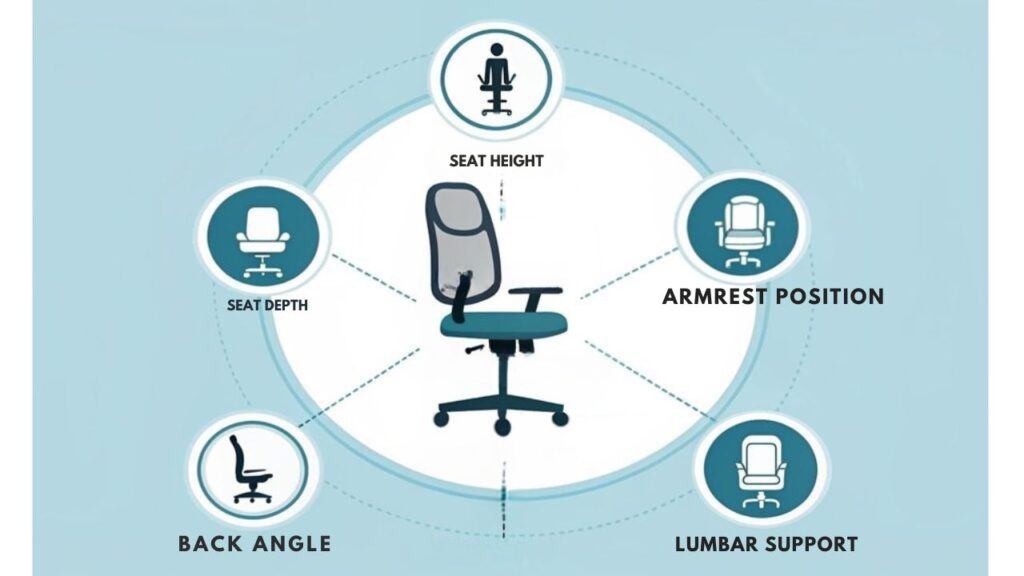
Making smart investments in ergonomic seating extends far beyond the initial customization features.
When you consider the long term savings associated with proper ergonomic support, you’ll find that quality chairs deliver substantial investment returns through reduced healthcare costs and enhanced productivity.
- Medical expense reduction: You’ll minimize potential costs from work-related injuries, including lower back pain, neck strain, and carpal tunnel syndrome.
- Productivity gains: Your enhanced comfort leads to fewer breaks and distractions, increasing daily output by up to 18%.
- Employee retention savings: You’ll reduce turnover costs as staff appreciate the investment in their well-being, saving on recruitment and training expenses.
Common Mistakes in Office Chair Selection

Have you noticed how easy it’s to make costly mistakes when selecting an office chair? You’ll want to avoid common oversights that can impact your productivity and health.
Many buyers focus solely on aesthetic design while neglecting vital ergonomic features like proper chair height and seat depth adjustability.
Don’t overlook the importance of customizable armrest height and adequate lumbar support – these features prevent strain during long work sessions.
Another significant error is choosing inappropriate chair material and seat cushion density for your climate and usage patterns.
You’ll also need to verify the weight capacity matches your needs and that mobility features suit your flooring.
Finally, confirm the backrest angle provides proper support for your specific tasks.
Adjusting Your Chair for Maximum Focus
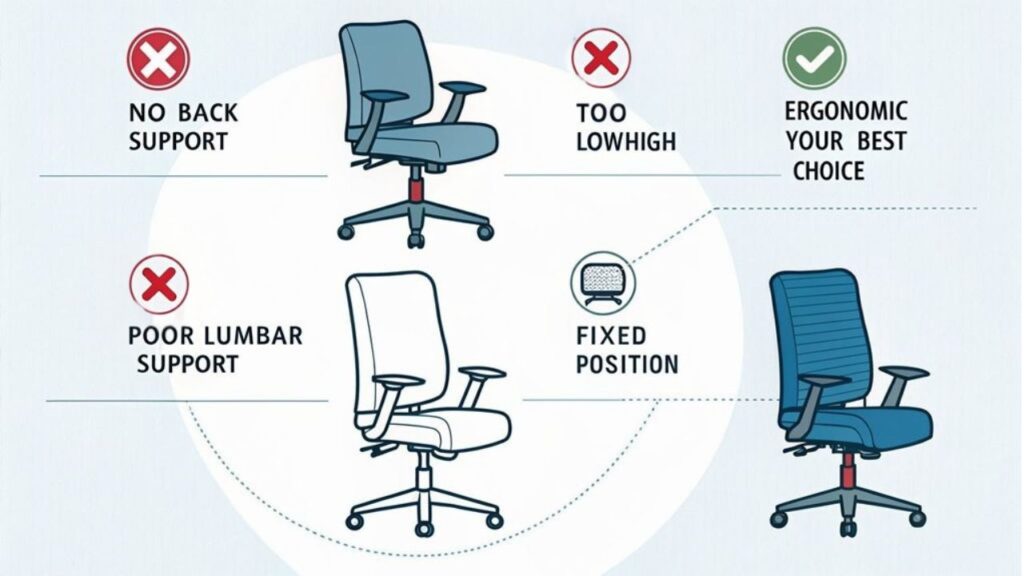
Once you’ve selected the right chair, proper adjustment becomes your next step toward ideal workspace performance.
Your body’s alignment directly impacts your ability to maintain focus throughout the workday. By enhancing your chair’s settings, you’ll create an environment that supports sustained concentration and productivity.
Here are the key adjustments you need to make:
- Set your chair height so your feet rest flat on the floor while your thighs remain parallel to the ground, maintaining proper blood circulation.
- Position the lumbar support to align with the natural curve of your lower back, reducing muscle strain.
- Adjust the seat depth to leave 2-3 fingers of space between the back of your knees and the chair’s edge, ensuring optimal weight distribution.
These precise adjustments will help you maintain proper posture and stay focused longer.
Signs Your Current Chair Is Hurting Productivity
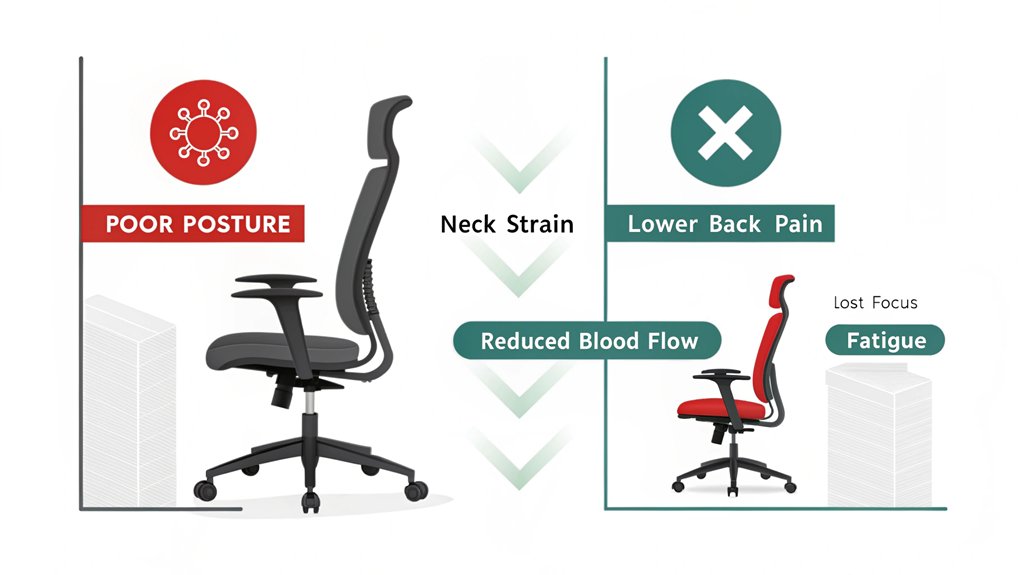
Several telltale signs indicate your office chair may be undermining your work performance. If you’re constantly shifting position, experiencing neck strain, or finding yourself standing up frequently to stretch, your chair isn’t supporting proper posture.
Chair discomfort leads to decreased concentration and a measurable productivity decline.
Watch for signs like numbness in your legs, lower back pain, or headaches that develop as your workday progresses. You might notice yourself slouching forward or perching on the edge of your seat – both indicators that your chair isn’t meeting your ergonomic needs.
If you’re taking more breaks than usual or feeling fatigued earlier in the day, your chair could be the culprit. These symptoms often correlate with reduced work output and diminished cognitive performance.
Research-Backed Evidence on Chair Ergonomics
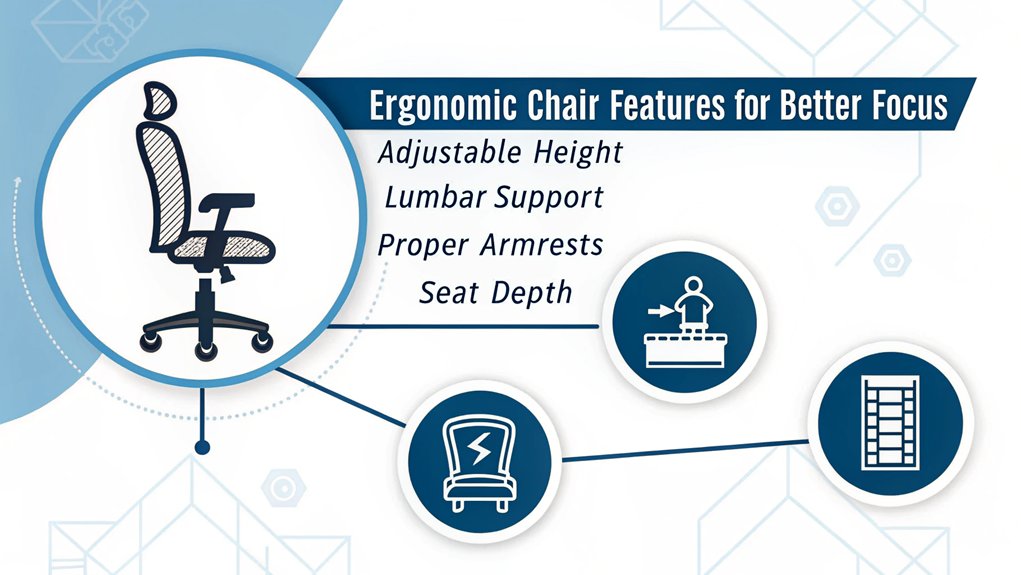
Research shows that ergonomic chairs can increase productivity by up to 17% through proper spine alignment and reduced physical strain during work hours.
You’ll find extensive scientific evidence linking improved posture to enhanced cognitive function, with studies documenting additional focused work time per day when using ergonomically-sound seating.
Recent workplace data indicates that employees using high-quality ergonomic chairs take 35% fewer breaks for discomfort and report 23% higher satisfaction with their ability to maintain concentration throughout the day.
Scientific Studies Support Benefits
While many people rely on anecdotal evidence about ergonomic chairs, scientific studies have consistently demonstrated their positive impact on workplace productivity and physical well-being.
Research confirms that proper ergonomic seating directly influences cognitive performance and overall efficiency at work.
Consider these research-validated ergonomic benefits:
- Studies show a 17% increase in task focus when using properly adjusted ergonomic chairs compared to standard office seating.
- Research demonstrates a noticeable reduction in musculoskeletal discomfort, leading to fewer work interruptions and enhanced concentration.
- Clinical trials indicate improved blood circulation and oxygen flow to the brain, resulting in sustained mental alertness during long work sessions.
You’ll find that investing in ergonomic seating isn’t just about comfort—it’s a scientifically proven strategy for optimizing your cognitive and physical performance.
Posture Impact on Performance
Poor posture from inadequate seating directly affects your cognitive abilities and work output throughout the day. When you slump in a non-ergonomic chair, you’re compromising your breathing capacity and blood circulation, which reduces oxygen flow to your brain by up to 30%. This physiological impact diminishes your focus and decision-making abilities.
Implementing posture correction through ergonomic seating can lead to measurable performance enhancement. You’ll experience improved spinal alignment, which optimizes your nervous system function and reduces mental fatigue.
The right chair supports your natural sitting position, enabling you to maintain proper posture without conscious effort. This automatic postural alignment lets you direct more mental resources toward your work instead of constantly adjusting your position.
As a result, you’ll sustain higher productivity levels across extended work periods.
Productivity Statistics and Data
Multiple studies confirm the substantial ROI of ergonomic chair investments through measurable productivity gains.
Recent ergonomic chair statistics demonstrate that proper seating solutions directly correlate with enhanced workplace performance and reduced absenteeism. You’ll find compelling productivity benchmarks supporting the business case for ergonomic investments.
- Workers using ergonomic chairs report fewer musculoskeletal complaints, leading to fewer sick days annually.
- Task focus increases by 17% when employees switch from standard to ergonomic seating, resulting in improved project completion rates.
- Companies investing in ergonomic chairs see an average 15% boost in daily productivity metrics and employee satisfaction scores.
These data-driven insights reveal that ergonomic seating isn’t just about comfort—it’s a strategic tool for maximizing workforce efficiency and maintaining competitive advantage in today’s dynamic business environment.
Frequently Asked Questions
Can Ergonomic Chairs Help Reduce the Effects of Existing Back Injuries?
You’ll find ergonomic chairs effectively manage back pain and support injury prevention through proper spine alignment, adjustable lumbar support, and customizable positioning that reduces strain on existing injuries.
How Often Should Ergonomic Chairs Be Replaced for Optimal Performance?
With 65% of office workers keeping chairs past their ideal lifespan, you’ll need to plan replacement frequency every 5-7 years to maintain proper ergonomic support and peak performance.
Are Ergonomic Chairs Suitable for Children Doing Homework at Home?
You’ll enhance your children’s posture and homework environment with properly sized ergonomic chairs. Select adjustable models that support growing bodies and guarantee feet touch the ground while maintaining correct positioning.
Do Ergonomic Chairs Require Special Maintenance or Cleaning Procedures?
Keep your chair in tip-top shape with basic cleaning techniques like vacuuming fabric, wiping mesh with damp cloth, and lubricating moving parts. Simple maintenance tips guarantee longevity of your ergonomic investment.
Can Ergonomic Chairs Help With Specific Medical Conditions Like Sciatica?
You’ll find sciatica relief through ergonomic chair features like lumbar support, adjustable seat depth, and proper tilt mechanisms, which reduce pressure on your sciatic nerve and promote better posture.
Conclusion
Like a well-tuned instrument that enables a musician to perform at their peak, your ergonomic chair serves as the foundation for ideal focus and productivity. You’ll notice immediate improvements in your mental clarity when you’ve properly adjusted your chair’s settings to support your unique physiology. By eliminating the physical distractions of poor posture, you’re equipping yourself with a precision tool that transforms your workstation into a cognitive enhancement zone.

I am a retired software engineer with experience in a multitude of areas including managing AWS and VMWare development environments. I bought a relative a mini-PC a year ago and have become passionate about the technology and its potential to change how we deploy software.

